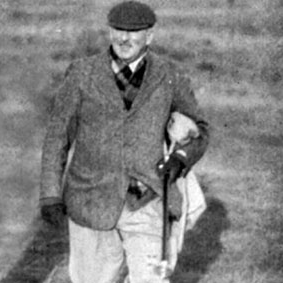
Major Sir Guy Colin Campbell was born on Jan 31, 1885 in Berkely Square, London and passed away on Oct 2, 1960 in Irvington, Virginia (aged 75). He went to the University of St. Andrews and also lived, worked and played extensive golf in St. Andrews, Scotland
Campbell was among the 30 newspaper men and women who were in attendance at the 1938 Walker Cup, and also at St. Andrews, when the Association of Golf Writers was founded.
Campbell joined the staff of the London Times in 1920 as a special correspondent and later as editor of sports under the legendary Bernard Darwin. He also wrote countless magazine articles on golf and several books. Most notable was his contribution to A History of Golf in Britain (1952) edited by Darwin.” From “The Golf Course” by Geoff Cornish and Ron Whitten.
Golf course design
Campbell’s best known work includes, but is not limited to:
BRITAIN & IRELAND: Ashridge GC (1932, with Stafford V. Hotckin & Cecil K. Hutchison) / Felixstowe Ferry GC, Suffolk (1947, reconstruction) / Killarney G&FC (1938, Mahony’s Point course with Henry Longhurst) / Prince’s GC, Kent (1950, redesign with John Morrison) / Rye GC, Kent (1938, modifications) / West Sussex (1931, with Hotckin & Hutchison).
CONTL EUROPE: Hilversum GC (1952, modifications) / Wimereux (1920s, with Hutchison).
Did you know?
Sir Guy Campbell was the great grandson of Robert Chambers, the early British golf historian and co-designer of the original 9-hole course at Royal Liverpool. Like his father, he was educated at Eton and the University of St Andrews, excelling at both rowing and cricket.
He was also a fine golfer, winning a number of medals in competition at St Andrews and he was a semi-finalist in the 1907 Amateur Championship at the Old Course, when John Ball claimed the sixth of his eight titles that year.
Campbell served in the infantry during the Great War and was wounded in action. He also enlisted during World War II with the Royal Rifle Corps, despite the fact that he was in his fifties by that time.
Guy started working alongside S.V. Hotchkin and C.K. Hutchison in the mid 1920s when the “Three Majors” formed a new company called Links and Courses to deal with a variety of golf course issues, including design, construction and maintenance.
Campbell, a family friend, was called in to help with the business, even though his experience outside golf journalism at The Times extended only as far as assisting Hutchison with a putting course at Hurlingham polo ground and rebuilding the coastal course at Wimereux, near Boulogne, in France.
He was a founding member of the International Society of Golf Architects, along with architects such as John Abercromby, C.H. Alison, Harry Colt, Herbert Fowler, Alister MacKenzie, Philip Mackenzie Ross and Tom Simpson. Formed in 1929, the society operated from secretary Tom Simpson’s office at his home in England.
Until the company dissolved in 1931, Links and Courses designed and built several layouts in the south of England, including Ashridge, Warsash, Shoreham, Leeds Castle, and West Sussex. Warash and Shoreham no longer exist but Ashridge remains a well-regarded hilly track laid out across a mix of parkland and woodland terrain.
Leeds Castle is home to a 9-hole course commissioned by Lady Baillie, the last private owner, who used to host lavish weekend house parties for her rich and famous friends. She felt that a vast expanse of beautifully laid-out trees and mowed grass, with the castle as the focal point in the middle, would create the idyllic country retreat.
West Sussex is a challenging course, with the 220-yard 6th one of the most formidable holes, played from an elevated tee across water to the green. It’s said to have caused disagreement between Campbell and his co-designer Hotchkin. Hutchison, the other partner in the firm, agreed with Hotchkin over the decision to modify the original short par four to the par three that’s in play today.
According to architect Jonathan Gaunt, “this meant there were two one shot holes in succession, but here it does not upset the balance of the first nine, because to most golfers, it plays more as a par four. The water features are naturally occurring bog and marsh, although the pond on the sixth was enlarged.
It is difficult to ascertain how West Sussex was created, especially when three strong minded individuals were working together on the design. It was after this project that the partnership ceased to exist, due to disagreements over certain aspects of design. It would also tend to suggest that there could well have been a clash of personalities.”
Outside England, Campbell is credited with modifications to the Championship course at Machrihanish, when some holes were lost to the adjacent airport, and he’s also been mentioned with regard to remodelling work at Killarney Golf Club in Ireland and Hilversumsche in The Netherlands.
Guy collaborated on projects with other architects, most notably with John Morrison when they renovated the courses at Prince’s Golf Club in Kent after World War II. Around the same time period, he teamed up with Henry Cotton to renovate nearby Royal Cinque Ports, as well as the Martello course at Felixtowe Ferry in Suffolk.
Extract:
From F.W. Hawtree‘s book The Golf Course: “Campbell was a Major at one time in the British Army. Guy Campbell also gave up the ‘Major’ when he succeeded to the baronetcy. He wrote Golf for Beginners in 1923 and devoted the eight pages of Chapter VI to diagrams and a swift tour d’horizon of building a golf course:
‘Make use of natural hazards but avoid trees. Avoid building up teeing grounds. Never build high plateau greens. On manures: use as little as possible then in the Spring. Weeding: do it by hand.’
All very terse and circumscribed.
But he later practiced what he preached in Britain, USA and France where he is reputed to have driven in a vintage Rolls Royce. On the back seat was a cage and in the cage was a parrot.”
- Thank you to – https://www.top100golfcourses.com/

Recent Comments